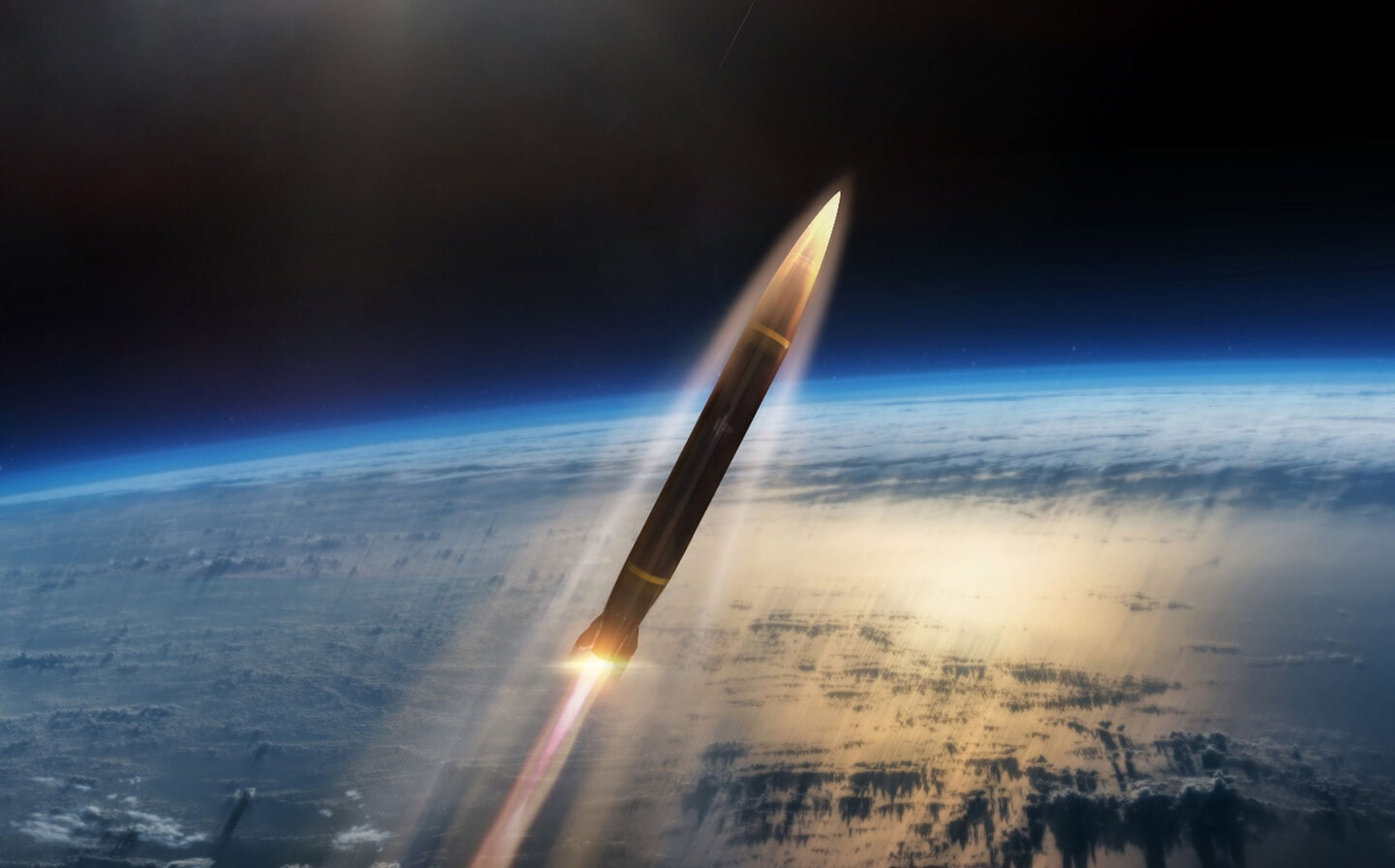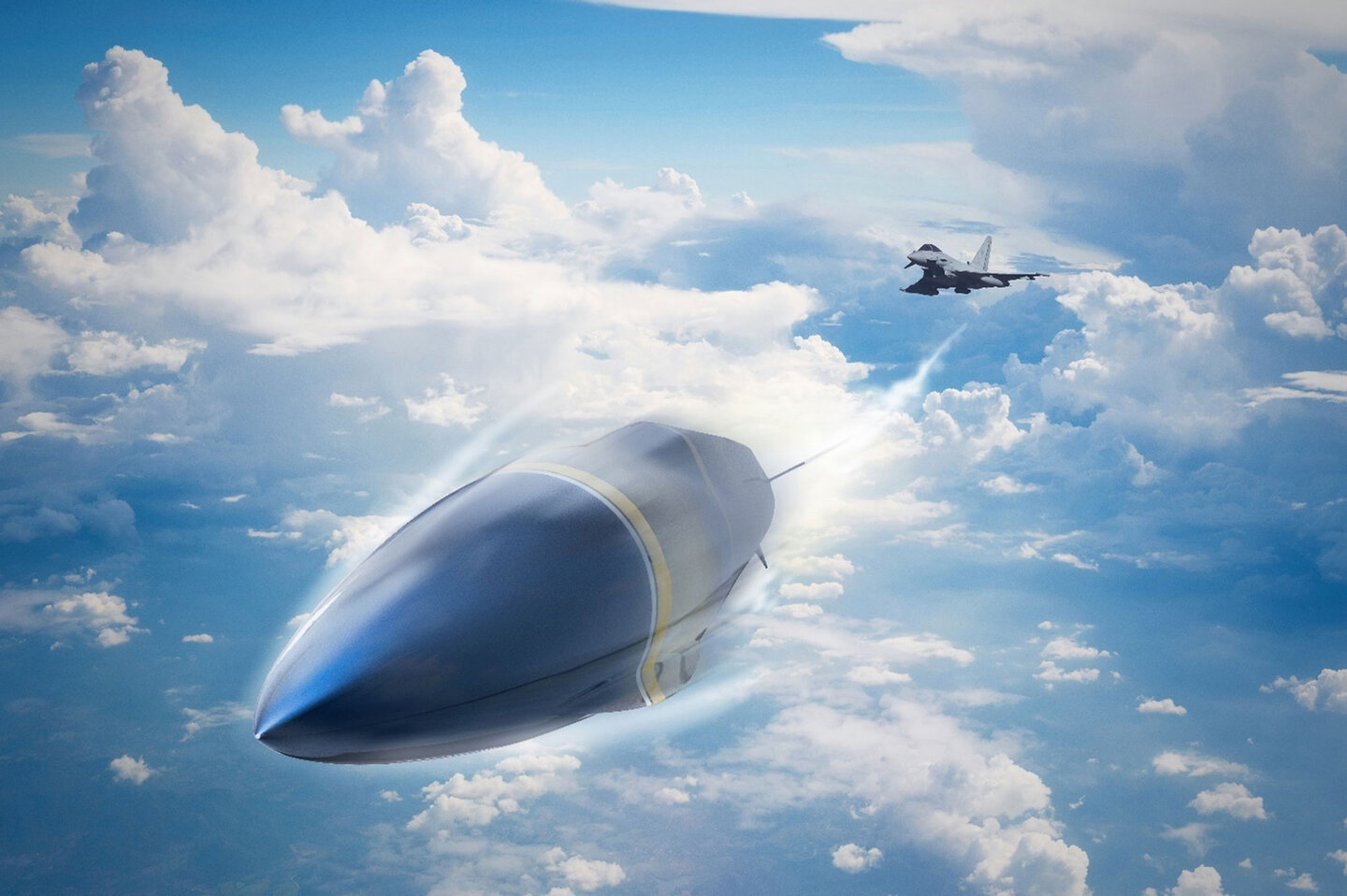Cover Story
Who has the hypersonic edge?
Although progress is being made at a technical level, problems arise with the methods governments and militaries use to cultivate sovereign hypersonic capabilities. John Hill reports.

Russia and the US are leading in hypersonic development. Credit: Metamorworks / Shutterstock
The global defence industry is innovating in response to a fractured security environment as companies begin to develop emerging military technologies that have never before been used in the battlespace.
Rearmament brings a more diverse range of capabilities beyond the artillery barrages that have come to define conflict in the past two centuries, albeit the role of these conventional methods still remain crucial as the Russia-Ukraine war demonstrates.
Among emerging capabilities, the potential of hypersonic weaponry has captured the imagination of military and government observers the most. The hypersonics industrial sector is even treated as a deterrent in its own right despite its limited, embryonic use against Ukraine.
Notably, there is no standard definition of the term ‘hypersonic’, which indicates the technology’s nascent progress. Typically, it refers to a weapon that is manoeuvrable at speeds from Mach five (five times the speed of sound) or higher. Ultimately, these hypersonic attributes make missiles more penetrable against enemy air defence systems.
Although progress is being made in hypersonics at a technical level, problems arise with the methods governments and militaries use to support the sector and to cultivate their own sovereign hypersonic capabilities.
From Russia with lies
Russian forces have used hypersonic missiles to suppress Ukrainian batteries and infrastructure since the beginning of its invasion of the country in February 2022. Moscow’s use of these missiles – particularly those of the ‘Kinhzhal’ family – has gradually shifted in that time, indicating the limited effects of the weapon in the campaign.
Kinzhal missiles, which Russia claims have a top speed of Mach 10, were originally used to target Ukraine’s advanced US-made Patriot batteries, which have since proven their mettle against the hypersonic weapon having intercepted a number of them in 2023 and 2024. As a result, these instances justify the argument that hypersonic weapons have not yet altered the balance of conflict, but also prove the power of Russian disinformation as a psychological weapon.
Slower weapons can help overload air defences, allowing a hypersonic missile to go through and deliver the ‘killing blow’
William Freer, research fellow in national security, Council of Geostrategy
However, it should be noted that this air-launched missile – more accurately considered an aeroballistic missile as it is not strictly ‘hypersonic’, lacking manoeuvrability at excessive speeds – is believed to be one of the least sophisticated weapons in Russia’s hypersonic arsenal.
Speaking to Global Defence Technology, William Freer, research fellow in national security, Council of Geostrategy, provided his assessment of the fledgling Russian Kinzhal:
“Initially it seemed that the Russians had the right idea in targeting Patriot batteries with their Kinzhals… However, it seems the Patriots were able to deal effectively with this threat, so the Russians no longer use them in this manner as far as I am aware,” Freer said.
Even the best laid plans do not survive the battlefield. Therefore, the Kinzhal was repurposed to enhance conventional missile salvos after their inability to penetrate Western air defence technologies on their own, despite Russian President Vladmir Putin’s bombastic praise of the Kinzhal since it was first produced in 2018.

MiG-31 combat aircraft flying with Kh-47M2 Kinzhal hypersonic air-launched ballistic missile on Russia Victory Day parade, 4 May 2018. Credit: Dianov Boris / Shutterstock
“Another potential best use for hypersonics, though, is to launch complex strike packages involving an array of weapons. Slower weapons can help overload air defences, allowing a hypersonic missile to go through and deliver the ‘killing blow’,” Freer explained.
This was seen in August, when the Kh-47M2, the Kinzhal ballistic missile, and Kh-101, the cruise missile variant, were used as part of the aggressor’s heaviest strikes against Ukraine to date.
Altogether, the strikes targetted more than half of Ukraine’s regions, that is 15 out of 24 Ukrainian oblasts. These systems were largely targetting Ukrainian critical infrastructure and causing significant damage to the energy grid ahead of Ukraine’s newfound ‘Victory Plan’ to turn the tide of the war in the autumn and winter period.
“However, this [hybrid salvo] does not seem to produce a cost-effective way of using hypersonic weapons and simply procuring larger numbers of cheaper strike weapons could have the same result.”
The relegated use of the Kinzhal proves the limited deployability of hypersonics in the strict sense of the word. This does not stop with the Kinzhal. Russia’s Zircon missiles are similarly questionable, with Freer designating it a “quasi-hypersonic” weapon.
Scramjet and ramjet: powering hypersonic missiles
Zircon is an air-breathing cruise missile, and the Russians have claimed it uses a scramjet but evidence from wreckage in Ukraine suggests this was not true (it would have been the first operational missile with a scramjet if it were) – it is most likely ramjet powered, Freer suggested.
Furthermore, the Zircon is most likely a heavily iterated version of Russia’s older P-800 Oniks cruise missile and Zircon most likely achieves a relatively short period of sustained hypersonic flight through a long and shallow dive phase.
“This does present challenges to air and missile defences, but far less so than a more capable hypersonic cruise missile would,” Freer detailed.
[Scramjet] is more complicated than a typical solid rocket motor, but much less than the turbine engines on some cruise missiles and jets
Jim Philpott, Northrup Grumman Fellow
Zircon is likely more difficult to intercept than Kinzhal, however the Ukrainians, in information released in August, claimed to have intercepted two Zircons of six fired (33% interception rate) and intercepted 28 Kinzhals of 111 fired (25%).
“The reason for the fact they have intercepted a greater percentage of Zircons is complicated,” Freer said. “It is down to what areas have been targeted (and what the air/missile defence coverage is like), and the desire to conserve interceptors and other factors.”
Scramjets differ from ramjets in how they compress air and combust fuel. This distinction makes the scramjet a supersonic version of the ramjet, although, the latter are more readily deployable while the former are still largely in the developmental phase.
The US defence industry appears to be leading the way in research for these engines, especially since Raytheon, an RTX subsidiary, was awarded government funds earlier this month to expand its manufacturing capacity in Tucson, Arizona, to accommodate the construction of the Hypersonic Attack Cruise Missile (HACM) for the US Air Force.

US companies are looking to develop hypersonic missiles. Credit: Lockheed Martin
Raytheon’s HACM weapon leverages Northrup Grumman’s scramjet propulsion: “It’s more complicated than a typical solid rocket motor, but much less than the turbine engines on some cruise missiles and jets. There are almost no moving parts inside the engine. It’s all about the design to manage the aerodynamic forces involved,” explained Jim Philpott, a Northrup Grumman Fellow.
HACM is funded under the aegis of the Eglin Wide Agile Acquisition Contract, a US Air Force funding mechanism that rapidly develops and acquires novel technologies. The military’s decision to place HACM within this rapid procurement programme demonstrates the priority of hypersonics.
Balancing the books: what’s needed to fight China?
In the West, countries are still facing their own issues around the future deployability of hypersonic missiles. While a fully-fledged hypersonic capability will enhance their arsenal in the coming years, global tensions lead analysts to predict that global conflict is more imminent. In some cases, within the next three to four years.
Justin Bronk, an air power specialist at the UK’s Royal United Services Institute (RUSI), estimated that “we need to be ready by 2028 to fight a war against the Russians because we may not have a choice about it.”
We need to be ready by 2028 to fight a war against the Russians
Justin Bronk, RUSI air power specialist
This examination of the Russian threat perception as an imminent crisis led to a corollary that military procurement ought to be more strategic. For Bronk, this means going back to basics – to “buy ammunition, buy spares, increase the size of your maintenance contracts” at the expense of costly novel programmes. Only so much can be prepared in such a short amount of time.
Bronk’s warning rings true to some extent, we need only reflect on what it takes to sustain the consumption rate of artillery and missiles in Eastern Europe and the Middle East. With the Indo-Pacific region engulfed in a gray-zone conflict that is barrelling towards outright war, most likely over Taiwan, then the US arsenal must outlast Chinese equipment stocks.
Mark Cancian, senior fellow, Center for Strategic and International Studies, conducted a wargame based on the US-China rivalry over Taiwan that plays out across the Indo-Pacific theatre. In such a conflict, hypersonics play an important but limited role.
“Hypersonics are very good at striking certain kinds of targets – high value, well defended targets. But at least with the current set of programmes and the current set of expectations, they are not a substitute for conventional cruise missiles and conventional missiles, because you just can’t buy enough of them.”

Arleigh Burke-class guided-missile destroyer USS Milius (DDG 69) launches a Standard Missile 2 Block 3A missile. Credit: US Navy
Notably, the Congressional Budget Office (CBO) assessed that buying 300 ground- or sea-launched, intermediate-range ballistic missiles with manoeuvrable warheads and sustaining the missile system for 20 years would cost a total of $13.4bn. It is estimated that the same number of comparable hypersonic missiles would cost about one third more, $17.9bn.
“The higher costs for hypersonic missiles partly reflect the complexity of building systems that can withstand the heat of hypersonic flight,” the CBO determined.
Still, as the Russians have failed to realise, emerging technologies require money and patience if any major military hopes to deploy the full military capability. Cancian called for a balance: “We should have them in our inventory, but they are not in themselves the solution to the problem posed by Chinese military forces, particularly naval and air forces.”
Britain: a strategic path to a sovereign capability
Close allies to the US, such as Britain, who are more fiscally constrained, ought to consider more closely what specific capability they need. However, this has not discouraged excessive ambition in the Ministry of Defence (MoD).
Some 90 organisations from across industry and academia have secured a place within the UK’s new £1bn ($1.25bn) Hypersonics and Capability Development Framework (HTCDF) in May this year. The initiative will also re-open to new suppliers every six to 12 months to ensure that the government can continue to draw upon new technologies and emerging market capabilities.
Could the UK find good uses for hypersonic weapons? Yes
William Freer, research fellow in national security, Council of Geostrategy
The UK continues to hold its breath over the forthcoming Strategic Defence Review, due for publication in the first half of 2025. This will serve as an assessment of UK defence priorities and offer some insight into the country’s position in a contentious security environment, which is now characterised as being in a state of ‘pre-war’.
Ahead of these findings, the new Labour government has set the tone for what will be an austere path to economic growth. The Chancellor, Rachel Reeves, informed the House of Commons of a £22bn ($28.86bn) ‘black hole’ in the public finances, which she added included unfunded military aid to Ukraine. Cuts are coming, and defence is no exception.
“Could the UK find good uses for hypersonic weapons? Yes,” Freer suggested. “But it must carefully consider what it wants them for and why – and what kind, there is no homogenous hypersonic weapon, there is a great deal of variety – unlike some states that develop these kinds of weapons for the prestige attached to it.”

UK Chancellor, Rachel Reeves, informs House of Commons of the £22bn ‘black hole’ in the public finances. Credit: Jessica Taylor/UK Parliament
It seems the HTCDF will support research and development (R&D) in UK hypersonics, imitating US development, as the government aims to leverage innovation by cultivating a competitive industrial environment at home. Crucially, this requires more than a £1bn. With about 70 years of hypersonics research under its belt, the US has poured several billions of dollars into the endeavour.
“There are certainly benefits to investing in the hypersonic infrastructure and R&D landscape in the UK but given how much investment could be needed and how long such a process could take this should be a secondary objective,” affirmed Freer.
Tapping into US industry
The UK will come to realise that it should take a strategic approach by leveraging US industry to fulfil its hypersonic capabilities. In doing so, the UK can also also stimulate economic growth at home.
Over the last seven years, Lockheed Martin has developed its Mako hypersonic missile which can be deployed in various ways – for support strike, maritime strike, counter-air defence and other missions.
European air forces have capabilities they are looking to fill in the near future
Clay Berardi, Lockheed Martin international business development manager
“Our ultimate vision, for Mako or similar programmes, is a missile built in the UK by skilled UK workers,” Lockheed Martin told Global Defence Technology. Mako can be deployed from fighters for stand-in strike and can reach operationally significant ranges that keep aircraft at safe standoff distances.
“Lockheed Martin is seeking opportunities to support UK MoD efforts to develop and field a sovereign hypersonic strike capability via AUKUS,” stated Clay Berardi, international business development manager at Lockheed Martin.
This trilateral alliance between Australia, the UK and US – countries which cooperate closely in developing a range of emerging capabilities through the second pillar initative – will prove useful for Britain’s hypersonic capability. In particular, the three states have introduced sweeping exemptions to export controls among the three partner nations in August this year.
“Our multi-mission Mako hypersonic missile is a great example of a programme that might be the focus of such a collaboration if the US approves,” Berardi said.

An artist’s impression of a Eurofighter Typhoon firing a hypersonic Mako missile. Credit: Lockheed Martin
The versatility of the Mako does also extend to the fourth generation Eurofighter Typhoon, of which the Royal Air Force operate 141 units in three tranches, according to GlobalData intelligence.
“European air forces have capabilities they are looking to fill in the near future,” Berardi identified. “Lockheed Martin is ready to implement solutions for fourth and fifth generation fighters that can help them achieve their goals.”
Caption. Credit:

Phillip Day. Credit: Scotgold Resources
Total annual production
Australia could be one of the main beneficiaries of this dramatic increase in demand, where private companies and local governments alike are eager to expand the country’s nascent rare earths production. In 2021, Australia produced the fourth-most rare earths in the world. It’s total annual production of 19,958 tonnes remains significantly less than the mammoth 152,407 tonnes produced by China, but a dramatic improvement over the 1,995 tonnes produced domestically in 2011.
The dominance of China in the rare earths space has also encouraged other countries, notably the US, to look further afield for rare earth deposits to diversify their supply of the increasingly vital minerals. With the US eager to ringfence rare earth production within its allies as part of the Inflation Reduction Act, including potentially allowing the Department of Defense to invest in Australian rare earths, there could be an unexpected windfall for Australian rare earths producers.
